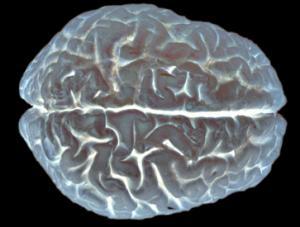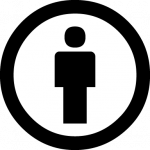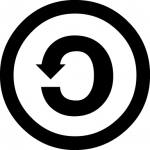
Image adapted from EUSKALANATO under a Creative Commons license: BY-NC-SA.
This course sequence teaches the pathophysiology of common diseases of the nervous system (including visual, auditory, and vestibular systems), and the general principles underlying diagnosis and management. The specific goals are:
- To review clinically relevant neuroanatomy and neurophysiology.
- To learn a systematic approach to the localization of neurologic lesions.
- To learn a systematic approach for determining the likely general category of disease process responsible for a patient’s symptoms and signs, based primarily on localization and time course.
- To learn about some common symptom complexes and diseases of the nervous system, (including visual, auditory, and vestibular systems) with respect to clinical features, pathology, pathophysiology, approach to diagnosis, and approach to management.
Sequence Directors:
Douglas J. Gelb, Ph.D., M.D.
Shahzad Mian, M.D.
H. Alexander Arts, M.D.
dScribe: Tau Zhu
Syllabus
Overview
The purpose of this course sequence is to teach the pathophysiology of common diseases of the nervous system (including visual, auditory, and vestibular systems), and the general principles underlying diagnosis and management. The specific goals for students are:
- To review clinically relevant neuroanatomy and neurophysiology.
- To learn a systematic approach to the localization of neurologic lesions.
- To learn a systematic approach for determining the likely general category of disease process responsible for a patient’s symptoms and signs, based primarily on localization and time course.
- To learn about some common symptom complexes and diseases of the nervous system, (including visual, auditory, and vestibular systems) with respect to:
- clinical features
- pathology
- pathophysiology
- approach to diagnosis
- approach to management
This is a lot of material to cover in three weeks. We (the faculty) have tried to be realistic and practical in our expectations, but we also feel obliged to present material we think you will need when you begin to take care of patients (not to mention when you take the Step 1 and Step 2 exams). Thus, some of the information included in the syllabus, slides, lectures, and textbook is provided mainly for future reference or to put topics in perspective, and we will not be testing you on it. We have tried to identify that material as clearly as possible, usually in the learning objectives on the first page of the syllabus section for each lecture. Even so, there is no escaping the fact that you will have a lot to learn in the next three weeks, some of which will require memorization. It would be pointless (and painful) to try to include everything in lecture. The lectures are intended to put things into context, to give you a framework for organizing your thinking about a topic, to emphasize key points, and to clarify concepts that are potentially confusing or particularly difficult. You will need to supplement the lectures with the syllabus, the NeuroLogic tutorial, and assigned pages in the textbook.
The content of this sequence obviously overlaps what you will be learning in your 3rd year neurology clerkship. The main distinction is that this sequence emphasizes the pathology and pathophysiology of disease processes; while you will also learn about diagnosis and management, the level of detail will be much less than in your clerkship when you will actually be taking care of patients.
Teaching Methods
Most of the course will be taught in lectures. There will be patient presentations on Monday, Nov. 3 (8:00), Friday, Nov. 7 (1:00), Monday, Nov. 10 (1:00), Tuesday, Nov. 18 (1:00), and Thursday, Nov. 20 (1:00).
Note: at the patient presentations on Nov 7, Nov. 10, and Nov 20, there will be optional quizzes taken via the audience response system. For those who choose to participate, scores will be saved, and the students with the top cumulative scores at the end of the sequence will receive a prize. To avoid intruding on the time set aside for the patients, the quizzes will begin promptly at 1:00 (NOT 1:10). Please arrive a little before this, and try to keep the noise level low during the quiz, since the patient will generally be present.
On Monday, Nov. 5 at 10:00, immediately after the introductory lecture, you will have time to work on a computer tutorial covering the principles of neurologic localization. This can be done in any location, but Dr. Gelb will be available to answer questions in the LRC.
The longitudinal case discussions will take place each Wednesday afternoon, Nov. 5, Nov. 12, and Nov. 19 (1:00-3:00). Material covered in those sessions is not formally a part of the Neuroscience Sequence.
There will be three neuropathology laboratory sessions. They will be 1:00 – 3:00 on Thursday 11/6/08, Thursday 11/13/08, and Friday 11/14/08.
Textbooks and Reading Material
You should already have the textbook, Kumar V, Fausto N, Abbas A. Robbins and Cotran Pathologic Basis of Disease, 7th edition (Philadelphia: Saunders, 2004), which has been required for other sequences, and is also required for this one.
There is one textbook required specifically for this course: Gelb DJ. Introduction to Clinical Neurology, 3rd edition (Philadelphia: Elsevier/Butterworth-Heinemann, 2005). This book is also required for the third year neurology clerkship. It has a very clinical focus, and includes only brief discussions of pathology and pathophysiology, so it has been supplemented with the course syllabus. Conversely, some clinical topics are covered only briefly in the syllabus, because the coverage in the textbook is more than enough. In those situations, specific pages in the textbook are always cited. In short, the textbook and the syllabus are complementary; neither one alone contains all the material for the course. The slides will supplement both, but obviously will not contain all the information you will be expected to know. The textbook and syllabus narrative have very few figures, so some slides are intended primarily to serve as illustrations for you to study on your own, and will not be discussed extensively in lecture. The slides will be available on the CTools Portal. For reference, the syllabus also includes a list of abbreviations and a table of muscle innervations (i.e., the nerves and nerve roots that supply clinically important muscles).
You will also be provided with a CD containing the Neuro Logic computer tutorial, intended to help you review pathways and learn the principles of neurologic localization. You will definitely be tested on this material.
All of the information required for the quiz and the examination will be presented in lecture, the syllabus (including the neuropathology syllabus), the assigned pages in the required textbook, or the Neuro Logic tutorial; no single one of these sources will cover everything included on the quiz and examination. You will not be tested on textbook pages that were not specifically cited in the syllabus material or lectures.
Other useful books (recommended, not required) are:
- Blumenfeld H. Neuroanatomy Through Clinical Cases (Sunderland: Sinauer Associates, 2002)
- Trobe JD. Physician’s Guide to Eye Care. 3rd edition (American Academy of Pediatrics, 2006)
- Martin JH. Neuroanatomy: Text & Atlas. 3rd edition (McGraw-Hill, 2003) [NOTE: This was the recommended text for the M1 Neuroscience sequence]
- Gray F, Poirier J, Girolami U. Escourolle & Poirier Manual of Basic Neuropathology. 4th edition (Butterworth-Heinemann, 2004)
- DeLisa JA, Gans BM (eds). Rehabilitation Medicine: Principles and Practice, 3rd edition (Philadelphia: Lippincott-Raven, 1998) is also recommended. Copies of the recommended textbooks will be placed on reserve in Taubman Library.
Examinations and Grading
Grading will comply with M2 grading policies. A pass/fail system will be used, and a cumulative grade of 75% or higher will be required for a passing score. Cumulative grades of 74.99% or lower will be assigned a failing grade.
The sequence will include one computer-based quiz (to be taken between Friday, Nov. 7 at 5 PM and Sunday, Nov. 9 at 11:59 PM)), a computer-based final (to be taken between Saturday, Nov. 22 at 8:00 AM and Wednesday, Nov. 26 at 5:00 PM) and a computer-based Neuropathology laboratory final (also to be taken between Saturday, November 22 at 8:00 AM and Wednesday, Nov. 26 at 5:00 PM). The Neuropathology laboratory exam will make up 10% of the total grade. The quiz and final exam will make up the remaining 90% of the total grade. Specifically:
10% of the final grade is based on lab exam
18% of the final grade is based on the quiz (about 30 questions)
72% of the final grade is based on the final exam (about 120 questions in all – 20 covering the first week, 50 covering the second week, and 50 covering the third week)
Instructors
Sequence Coordinators
Neurology:
Douglas Gelb, M.D., Ph.D.
Neurosurgery:
Hugh Garton, M.D.
Ophthalmology:
Shahzad Mian, M.D.
Otolaryngology:
H. Alexander Arts, M.D.
Neuropathology:
Constance D’Amato, M.S.
Pharmacology:
Marshal Shlafer, Ph.D.
Additional Faculty
Ophthalmology:
Jonathan Trobe, M.D.
Terry Bergstrom, M.D.
Otolaryngology:
Hussam El Kashlan, M.D.
Teresa Zwolan, Ph.D.
Philip Zazove, M.D.
Neuropathology:
Mila Blaivas, M.D., Ph.D.
Andrew Lieberman, M.D., Ph.D.
Paul McKeever, M.D., Ph.D.
Learning Outcomes
The purpose of this course sequence is to teach the pathophysiology of common diseases of the nervous system (including visual, auditory, and vestibular systems), and the general principles underlying diagnosis and management. The specific goals for students are:
- To review clinically relevant neuroanatomy and neurophysiology.
- To learn a systematic approach to the localization of neurologic lesions.
- To learn a systematic approach for determining the likely general category of disease process responsible for a patient’s symptoms and signs, based primarily on localization and time course.
- To learn about some common symptom complexes and diseases of the nervous system, (including visual, auditory, and vestibular systems) with respect to:
- clinical features
- pathology
- pathophysiology
- approach to diagnosis
- approach to management
The content of this sequence obviously overlaps what you will be learning in your 3rd year neurology clerkship. The main distinction is that this sequence emphasizes the pathology and pathophysiology of disease processes; while you will also learn about diagnosis and management, the level of detail will be much less than in your clerkship when you will actually be taking care of patients.
Reading List
Required Textbooks and Reading Material
You should already have the textbook, Kumar V, Fausto N, Abbas A. Robbins and Cotran Pathologic Basis of Disease, 7th edition (Philadelphia: Saunders, 2004), which has been required for other sequences, and is also required for this one.
There is one textbook required specifically for this course: Gelb DJ. Introduction to Clinical Neurology, 3rd edition (Philadelphia: Elsevier/Butterworth-Heinemann, 2005). This book is also required for the third year neurology clerkship. It has a very clinical focus, and includes only brief discussions of pathology and pathophysiology, so it has been supplemented with the course syllabus. Conversely, some clinical topics are covered only briefly in the syllabus, because the coverage in the textbook is more than enough. In those situations, specific pages in the textbook are always cited. In short, the textbook and the syllabus are complementary; neither one alone contains all the material for the course. The slides will supplement both, but obviously will not contain all the information you will be expected to know. The textbook and syllabus narrative have very few figures, so some slides are intended primarily to serve as illustrations for you to study on your own, and will not be discussed extensively in lecture. The slides will be available on the CTools Portal. For reference, the syllabus also includes a list of abbreviations and a table of muscle innervations (i.e., the nerves and nerve roots that supply clinically important muscles).
You will also be provided with a CD containing the Neuro Logic computer tutorial, intended to help you review pathways and learn the principles of neurologic localization. You will definitely be tested on this material.
Recommended Textbooks
- Blumenfeld H. Neuroanatomy Through Clinical Cases (Sunderland: Sinauer Associates, 2002)
- Trobe JD. Physician’s Guide to Eye Care. 3rd edition (American Academy of Pediatrics, 2006)
- Martin JH. Neuroanatomy: Text & Atlas. 3rd edition (McGraw-Hill, 2003) [NOTE: This was the recommended text for the M1 Neuroscience sequence]
- Gray F, Poirier J, Girolami U. Escourolle & Poirier Manual of Basic Neuropathology. 4th edition (Butterworth-Heinemann, 2004)
- DeLisa JA, Gans BM (eds). Rehabilitation Medicine: Principles and Practice, 3rd edition (Philadelphia: Lippincott-Raven, 1998) is also recommended. Copies of the recommended textbooks will be placed on reserve in Taubman Library.

Image adapted from EUSKALANATO under a Creative Commons license: BY-NC-SA.
| Document Title | Creator | Downloads | License |
|---|---|---|---|
|
11.17.08 Lecture Slides: Clinical Features of Visual and Ocular Motor Disorders |
Jonathan Trobe
|
||
|
11.17.08 Lecture Supplement: Clinical Features of Visual and Ocular Motor Disorders |
Jonathan Trobe
|
||
|
11.20.08 Lecture Supplement: Hearing Loss from a Family Doc's Standpoint |
Philip Zazove
|
||
|
11.20.08 Sample Test Questions: Hearing Loss from a Family Doc's Standpoint |
Philip Zazove
|
||
|
11.21.08(a) Lecture Slides: The Red Eye |
Jonathan Trobe
|
||
|
11.21.08(a) Lecture Supplement: The Red Eye |
Jonathan Trobe
|
||
|
11.21.08(b) Lecture Slides: Common Eye Symptoms |
Jonathan Trobe
|
||
|
11.21.08(b) Lecture Supplement: Common Eye Symptoms |
Jonathan Trobe
|
| Document Title | Creator | Downloads | License |
|---|---|---|---|
|
11.17.08: Clinical Features of Visual and Ocular Motor Disorders |
Jonathan Trobe
|
||
|
11.20.09: Hearing Loss from a Family Doc's Standpoint |
Philip Zazove
|
||
|
11.21.08(a): The Red Eye |
Jonathan Trobe
|
||
|
11.21.08(b): Common Eye Symptoms |
Jonathan Trobe
|
| Document Title | Creator | Downloads | License |
|---|---|---|---|
|
2006 Daily Schedule: M2 Neurosciences |
Dept. Staff
|
||
|
2007 Daily Schedule: M2 Neurosciences |
Dept. Staff
|
||
|
2008 Daily Schedule: M2 Neurosciences |
Dept. Staff
|
||
|
2009 Daily Schedule: M2 Neurosciences |
Dept. Staff
|


